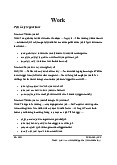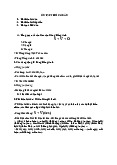


Preview text:
TỰ HỌC IELTS WRITING TASK 1
BẢNG TỪ VỰNG CHỈ XU HƯỚNG Xu hướng Động từ Danh từ to rise (to…/by …) a rise (of …)
to increase (to…/by …) an increase (of …) to grow (to…/by …) a growth (of …) to go up (to…/by …) an upward trend by + chênh lệch of + chênh lệch to fall (to…/by …) a fall (of …) to decline (to…/by …) a decline (of …)
to decrease (to…/by …) a decrease (of …) to drop (to…/by …) a drop (of …) do not change no change remain/stay + stable/ steady/ unchanged + at at giới từ đi kèm fluctuate around …/ fluctuation between … and … DỰ ĐOÁN Predictions show that S + will + … Expectations Anticipations It is predicted that S + will + … expected anticipated S + to be predicted to + verb + … expected anticipated LINKING In 1990, … Then, … Finally, … In the first year, … Next, … In the last year, … Blog Study motivation In the first two years, … After that, … … In January, … From 1995 onwards, … In the first month, … During the following two years, … This is followed by … PARAPHRASE
from 1990 to 2000 → between 1990 and 2000// over a period of 10 years// over a 10-year
period (lúc này year không có “s” nhé, vì cụm “10-year” đóng vai trò là tính từ).
every year → each year// per year// yearly// annually// on an annual basis
every day → each day// per day// daily// on a daily basis every week each w →
eek// per week// weekly// on a weekly basis
during the period shown during this time frame → duri → ng the given period
people who fell into the 40 to 49 age group = people falling into the 40 to 49 age group
people who were between 40 and 49 years old = people between 40 and 49 years old
people who were aged 40 to 49 = people aged 40 to 49. 40-to 49-year-old people 40-to 49-year-olds the 40-49 age group the 40-49s
people who were in their forties = people in their forties.
People in the age range of 40 to 49
People aged 65 or more = elderly/older people aged 65 or over spending on X exp →
enditure on X// the amount of money spent on X
the percentage of spending on X → the proportion of spending on X → the proportion of money spent on X
unemployment rates → levels of unemployment// levels of joblessness// unemployment
levels// the proportion of people who were unemployed// the proportion of people who
were jobless// the proportion of people without work poor people
→ people living under the poverty line people living in extreme poverty → poverty rates poverty l → evels
the consumption of X → the amount of X consumed// the number of X consumed// X consumption
the production of X → the amount of X produced// the number of X produced// X production car, bus and train thr →
ee different forms of transport forms of transport mean → s of transport modes of trans → port
the number of people driving to work the number of car users// the number of people → travelling by car
the number of people travelling by train the number of train users// the number of rail → passengers show
→ compare// indicate/ illustrate// give information about…
People in the UK British people// the British → People in the USA A → merican people
the percentage of the proportion of →




